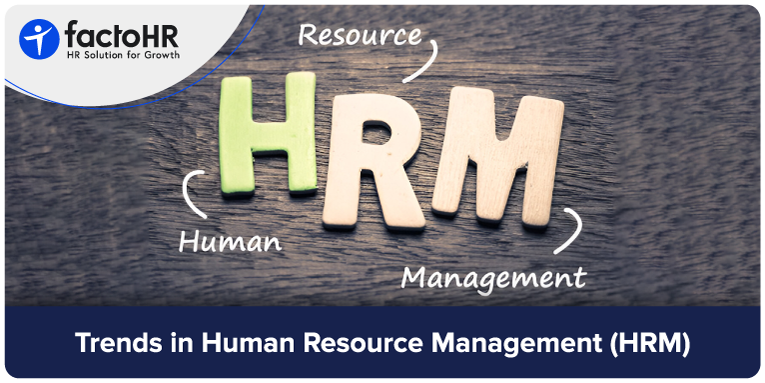6 HR Trends that Shape HR Management in 2025

Table of Contents
The HRM field is changing fast, just like every other business area. With new technology, rising employee expectations, and a constantly shifting world, the traditional HR rulebook is no longer practical. The trends in HRM that were effective ten years ago may not suffice in today’s connected workplaces.
Recent trends in HRM extend far beyond payroll and hiring. Relying on spreadsheets and outdated policies may subject companies to increased operational and financial loss. Whether your team is big or small, staying up-to-date with new trends in HR is crucial to remain relevant in the industry. Today’s workforce demands speed, innovation, and people-first strategies, and current HR practices must keep pace with these demands.
This blog discusses the most significant trends in Human Resource Management (HRM). These insights will help you prepare for the future and stay ahead in 2025 and beyond. These are not just minor changes but rather major shifts in how HR operates. HR personnel should research and prepare their organization for the future to make a big difference later.

Recent HR Trends to Watch in 2025
Several key trends are reshaping how HR teams function, communicate, and deliver value across organizations. Here are some of the latest trends in HR management in 2025 to look for:
AI and Automation in HR
Artificial Intelligence (AI) and automation continue to reshape HR practices. A recent study predicts that by 2025, AI will handle over 60% of HR tasks, including resume screening, interview scheduling, and employee onboarding. This shift will save time, improve accuracy, and reduce bias. By having AI handle repetitive tasks, HR can focus more on essential areas, such as workforce planning and employee engagement.
These tools excel in scanning large amounts of data to help you predict hiring needs, identify skill gaps, and retain employees. When considering the use of automation in HR plans, understanding AI in HR can provide a clearer direction.
However, AI integration does not merely involve technical considerations; it also requires careful analysis of workforce readiness. Organizations should begin by addressing common misunderstandings and concerns that employees may have. While some aspects of AI are still unclear, decisions should be based on facts, not fear. By encouraging curiosity and patience, especially among team members who may be hesitant or unsure, AI can be integrated in a way that supports and empowers employees.
Integrating new technologies is always a challenge, and to overcome this, HR personnel can find creative ways to engage employees. They could schedule gamified learning sessions and interactive workshops. Any progress should also be rewarded and recognized to gain support from all employees. These programs would develop a culture that encourages innovation and responsible use of AI.
Remote and Hybrid Work Models
One of the strongest HR trends in 2025 is the continued shift toward hybrid working models. While some companies initially pushed for return-to-office policies, most have come to accept that flexibility has become the new standard. Recent surveys indicate that approximately 75% of companies plan to maintain flexible work options.
Besides convenience, this working model provides practical advantages for both employers and employees. Hybrid work models enable organizations to collaborate with highly talented and skilled individuals who may have faced barriers in traditional office settings, such as those with disabilities or new mothers. People who may not thrive in rigid environments can still deliver exceptional results when given the autonomy to choose where, when, and how they work.
However, hybrid work requires careful planning and management. This includes updating outdated HR policies, adopting remote-friendly technology, and creating systems that support work-life balance.
Employee Experience and Well-Being
Today, organizations offer employees more benefits for their well-being than in the past. Neglecting employee well-being not only affects morale but also costs companies millions of dollars yearly.
Studies estimate that burnout alone costs companies up to $5 million annually for every 1,000 employees. Disengagement results in an additional $1.9 trillion in lost productivity across the U.S. Meanwhile, staff replacement can cost a company between 30% and 200% of an employee’s salary per turnover.
The past few years have demonstrated that prioritizing mental health and work-life balance is one of the most effective strategies for employee retention. For working parents, caregivers, and individuals facing personal challenges, flexibility and emotional support are crucial for staying engaged and motivated.
To foster a sense of belonging within an inclusive work culture, many companies are investing in employee wellness programs. Research shows that organizations investing in these programs report 30% higher engagement and 25% lower turnover rates.
The purpose of these initiatives is to reduce absenteeism while fostering a change in company culture. Companies are creating environments that give employees freedom, help them find purpose in their work, and make them feel like they’re part of something bigger. Employees who feel seen, heard, and supported are far more likely to stay, thrive, and grow within the organization.

Upskilling and Reskilling
The business world has become increasingly competitive, and to stay relevant, upskilling employees’ skills, as well as knowledge, has become necessary. To encourage employees to participate in upskilling programs, HR managers should develop organizational policies that promote professional advancement. To achieve this, continuous learning, training, and development should be implemented, and employees who show growth should also be considered for leadership roles.
However, organizations need to be mindful that training should go beyond courses and certification. It should empower employees to grow with a sense of purpose. For instance, organizations may help a veteran employee explore leadership or teach a junior member new tools. In both cases, they are building a strong skill base and future-proofing careers. Statistics show that companies that encourage learning are 30-50% more likely to lead innovation in their field.
Several HR tools can be utilized for this purpose. HR software enables the creation of custom learning paths and tracks real-time progress across the organization. These platforms connect talent with opportunities and make sure learning investments create real business value.
HR Tech and Data-Driven Decision-Making
HR technology is transforming the way HR teams operate. Cloud-based platforms are scalable, easy to access, and integrate seamlessly across payroll, benefits, compliance, and other HR jobs. These tools enable companies to work more efficiently and provide their employees with more support. It also makes it easier to find and retain good talent, thus building a resilient workforce.
The modern Core HR platform provide centralized control, automating manual tasks and ensuring regulatory compliance, which simplifies the job for HR teams.
When used correctly, HR analytics helps identify what is successful and what requires improvement. With the right usage of workforce data, HR leaders can shape strategies that work. For instance, tracking employee engagement scores can pinpoint teams at risk of burnout, while learning data reveals which training programs yield the best results.
Diversity, Equity, and Inclusion (DEI) Initiatives
Diversity, equity, and inclusion are powerful corporate initiatives. Recent studies have spotted that diverse teams are 35% more likely to deliver above-average returns and 70% more likely to capture new markets. The reason is that diverse teams are quicker to solve problems, more adaptable, and way better at spotting new opportunities.
By 2025, DEI initiatives will be deeply integrated into every aspect of the HR function. From hiring and onboarding to promoting and retaining talent, today’s leaders are expected to build cultures where every employee’s contribution is valued and respected.
Successful organizations are leveraging HR tech to minimize unconscious bias in recruitment and track diversity KPIs over time. But tools alone aren’t enough to achieve the desired results. Equity means providing individuals with the necessary training and helping leaders learn how to effectively include everyone.
Making DEI a part of the employee experience not only enhances innovation but also strengthens the employer’s brand. To foster an inclusive and accountable culture, HR policy should be consistent and fair throughout the organization.
Why Staying Updated with HR Trends Matters
Companies must keep pace with the changing trends in human resource management (HRM) to stay ahead of their competitors. With these new methods, businesses operate more effectively, and employees are more satisfied. Companies that adopt these new HR ideas will find it easier to hire top talent, retain skilled workers, and build future-ready teams.

Final Thought
Current trends in HRM focus on the use of technology, flexible working models, prioritizing employee health, and making informed decisions. Companies that adopt these latest trends in human resource management will have stronger and more enthusiastic teams ready for the future. To keep up with these changes, every organization needs to measure key HR metrics. Assessing these metrics helps organizations evolve and remain competitive in the business market.
The latest HR trends have transformed traditional approaches, now focusing on ensuring that employees have exceptional work experiences. To be successful in HR, utilizing effective HR software, such as recruitment software, attendance management software, or payroll software, can be a game-changer.
And that’s precisely where factoHR comes in.
factoHR helps you effortlessly manage core HR tasks, like attendance and leave, making life simpler for everyone. Prepared to make HR simpler and more powerful? factoHR is your answer!
Frequently Asked Questions
What are the Current Trends in HR?
Current HR trends focus on hybrid work, employee experience and well-being, diversity, equity, and inclusion (DEI), AI and automation, data-driven HR, upskilling, skills-based hiring, and increased transparency.
What are the Emerging Trends in HRM?
Emerging trends in Human Resource Management (HRM) reflect global shifts in how organizations manage their workforce. These include the growing use of AI to streamline hiring and onboarding processes, personalized employee experiences, blended workforces that combine full-time staff and freelance workers, and continuous learning through upskilling and reskilling. There is also a shift toward flexible leadership styles that prioritize empathy, frequent feedback, and employee well-being as core business strategies.
What are the Future Trends in HR?
Future trends in HR point to what’s next. Expect more intelligent automation, AI-led decision-making, predictive analytics for workforce planning, and even virtual reality (VR) for training and collaboration. As the workplace evolves, flexible work will become the norm rather than the exception, and DEI strategies will extend beyond hiring to encompass every stage of the employee journey. Emotional intelligence, ethical AI use, and purpose-driven leadership will also take center stage.
What are the Trends in the HR Industry in India?
Recent trends in HRM in India include unique workforce dynamics, a young population, and digital transformation across sectors. Companies are increasingly investing in hybrid work policies, AI-based recruitment, and mobile-first HR platforms to engage a tech-savvy workforce. There is also growing attention to DEI in tier-2 and tier-3 cities, regional language support in HR tools, and demand for skilling initiatives driven by government and private partnerships, such as Skill India and NAPS.
What are the Tips to Prepare for Changes in the HR World?
To prepare for changes in the HR world, organizations should:
- Stay informed about technological advancements and human resources innovations.
- Prioritize continuous learning and development for HR professionals.
- Focus on adaptability and flexibility within the organization.
- Engage employees in discussions about their needs and expectations to ensure alignment and mutual understanding.
- Develop data literacy to use analytical tools for decision-making.
Grow your business with factoHR today
Focus on the significant decision-making tasks, transfer all your common repetitive HR tasks to factoHR and see the things falling into their place.

© 2025 Copyright factoHR


